What is Adware and Why Adware is dangerous for your computer ? The Adware is a program that absolutely unnecessary for the normal operation of the computer and does not perform any useful functions. All its activities boil down to one thing: show ads in all open windows of Internet browsers, such as Google Chrome, Opera, Mozilla Firefox, Microsoft Internet Explorer, Opera or Edge. That is, your browser is just a screen for displaying very annoying ads.

The creators of adware do not think about whether you are watching these annoying ads or not, their main task is to demonstrate as many ads as possible, since they receive money just for the number of ad impressions. As a result, after the adware was installed on a computer, going online became a “bad idea”. As soon as the adware will notice that Internet access is open, it immediately tries to launch the browser and open in it a randomly selected ad site. Moreover, immediately after the opening of the first site, another opens, and if you do not quickly close the ad web sites, then after some time, the harmful activity of the adware will cause the computer to slow down very much or stop responding to your commands.
Therefore, if you open any page, even the one on which you have not previously seen ads, you are greeted by a large number of banners and pop-up ads, or when the computer is turned on, the browser starts automatically, immediately showing an ads, then your personal computer is infected with adware.
You need to check the computer as soon as possible, find and remove adware, as its presence can lead to slow operation of the operating system, slowing down the download speed of websites and even stealing your personal information and data that you enter in your Internet browser.
Remove adware from Windows 10 (Virus removal guide)
Without any doubt, the adware damages your computer. Therefore, it is necessary to remove adware quickly and, most importantly, completely. To get rid of the adware, follow the step-by-step guide below. You will need to use several free programs designed specifically to combat adware, as well as perform some simple actions with the settings of the operating system and installed Internet browsers.
We strongly recommend that you follow all the steps below, because each part of the instruction is important in its own right and only after completing it from start to finish, you can be sure that your computer has been cleared of the adware and protected from possible infection with adware in the future. During this procedure, you may need to restart your computer or browser, so we recommend printing this guide or bookmarking this page. If during the removal of adware you have questions or something will not work, then just write us about it. We will gladly help you remove adware from your computer.
To remove Adware from Windows 10, complete the following steps:
- How to remove adware from Windows 10 manually
- How to remove adware from Windows 10 with free tools
- Install AdBlocker
- How did you get infected with adware
- Finish words
How to remove adware from Windows 10 manually
Read this “How to remove” section to know how to manually remove adware from Windows 10. Even if the tutorial does not work for you, there are several free adware removers below that can easily remove adware and thus rid your computer of annoying ads.
Delete questionable software using Windows Control Panel
Very often adware gets to the computer as part of various free programs. Therefore, it is obvious that by uninstalling these programs, you can also remove adware itself.
But before you open the Control Panel and remove suspicious programs, you need to do the following: make sure you have closed all internet browsers and other software. Press CTRL, ALT, DEL keys together to open the MS Windows Task Manager.

Click on the “Processes” tab, look for something suspicious that is the adware then right-click it and select “End Task” or “End Process” option. In most cases, adware masks itself to avoid detection by imitating legitimate Microsoft Windows processes. A process is particularly suspicious: it’s taking up a lot of memory (despite the fact that you closed all of your applications), its name is not familiar to you (if you are in doubt, you can always check the program by doing a search for its name in Google, Yahoo or Bing).
Now you need to open the Windows Control Panel. Click the Windows button, type “Control panel” in search and press Enter. Select “Programs and Features”, then “Uninstall a program”.
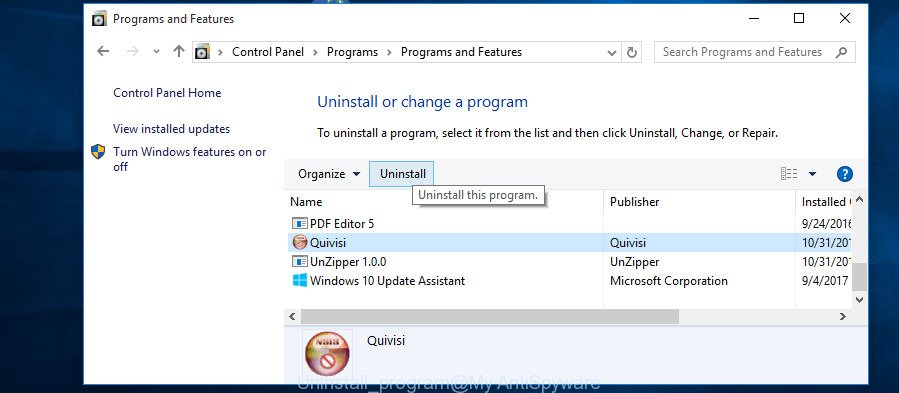
Look around the entire list of software installed on your computer. Most likely, one of them is the adware. Select the questionable program or the application that name is not familiar to you and uninstall it. We recommend taking this step very seriously, despite its simplicity!
Remove adware from Internet Explorer
In case the Internet Explorer browser was infected with adware and its settings were changed, then you need to reset Microsoft Internet Explorer to the state, which was when the MS Windows was installed on your PC.
First, run the Internet Explorer. Next, click the button in the form of gear (![]() ). It will show the Tools drop-down menu, press the “Internet Options” like below.
). It will show the Tools drop-down menu, press the “Internet Options” like below.

In the “Internet Options” window click on the Advanced tab, then click the Reset button. The IE will open the “Reset Internet Explorer settings” window as displayed in the following example. Select the “Delete personal settings” check box, then press “Reset” button.

You will now need to reboot your personal computer for the changes to take effect. If the reset did not help to remove adware from Internet Explorer, then check the list of installed extensions and delete all that cause even the slightest suspicion. Unfortunately, there are cases when to remove adware, you may need to completely reinstall the Internet Explorer browser.
Remove adware from Firefox
If you find that your Mozilla Firefox has been attacked by an adware or the adware has changed the browser settings, then you need to perform a special procedure, which is called “Refresh Firefox” (Reset Firefox settings). The “Reset settings” feature can solve most of the problems caused by the adware. Despite the fact that this procedure is called “Reset settings”, you do not need to be afraid. All your personal information will not be deleted, including bookmarks, browsing history, passwords, cookies, auto-fill data and personal dictionaries.
First, start the Mozilla Firefox and click ![]() button. It will display the drop-down menu on the right-part of the internet browser. Further, click the Help button (
button. It will display the drop-down menu on the right-part of the internet browser. Further, click the Help button (![]() ) like below.
) like below.

In the Help menu, select the “Troubleshooting Information” option. Another way to open the “Troubleshooting Information” screen – type “about:support” in the web-browser adress bar and press Enter. It will show the “Troubleshooting Information” page as shown on the image below. In the upper-right corner of this screen, click the “Refresh Firefox” button.

It will show the confirmation prompt. Further, press the “Refresh Firefox” button. With these actions you will start the process of resetting the browser settings. During this process, all extensions will be disabled, the browser settings that have been modified by the adware are restored.
Remove adware from Google Chrome
If you use the Chrome browser and during the adware attack on your computer, the browser settings have been changed or worse, the adware infected the browser itself, then resetting the settings can help you. Despite the fact that this is a standard function of Google Chrome, it has great capabilities and often helps to easily get rid of all malicious actions of adware. When performing a reset, all your personal data will not be deleted, bookmarks, passwords, auto-fill data will be saved.

- First, run the Google Chrome and click the Menu icon (icon in the form of three dots).
- It will show the Google Chrome main menu. Choose More Tools, then click Extensions.
- You’ll see the list of installed extensions. If the list has the add-on labeled with “Installed by enterprise policy” or “Installed by your administrator”, then complete the following instructions: Remove Chrome extensions installed by enterprise policy.
- Now open the Chrome menu once again, press the “Settings” menu.
- Next, click “Advanced” link, that located at the bottom of the Settings page.
- On the bottom of the “Advanced settings” page, click the “Reset settings to their original defaults” button.
- The Chrome will open the reset settings dialog box as on the image above.
- Confirm the web-browser’s reset by clicking on the “Reset” button.
- To learn more, read the blog post How to reset Chrome settings to default.
Fix infected web browsers shortcuts that have been modified by adware
During the attack on the computer, in addition to changing the browser settings and installing malicious browser extensions, the adware can also change the shortcuts of all installed browsers. The adware can add an argument like “http://site.address” into the Target property of the desktop shortcut file for the Firefox, Google Chrome, MS Edge and Internet Explorer. Due to this, it is very important when manually removing the adware, you need to check all the browser shortcuts, otherwise you can allow the adware to be installed on the computer simply by running the browser using an infected shortcut.
Right click on the web browser’s shortcut file, click Properties option. On the Shortcut tab, locate the Target field. Click inside, you will see a vertical line – arrow pointer, move it (using -> arrow key on your keyboard) to the right as possible. You will see a text “http://site.address” which has been added here. Remove everything after .exe. An example, for Google Chrome you should remove everything after chrome.exe.

To save changes, click OK . You need to clean all web browser shortcut files. So, repeat this step for the MS Edge, Mozilla Firefox, Chrome and Internet Explorer.
Delete scheduled tasks that were created by adware
Once installed, the adware can add a task in to the Windows Task Scheduler Library. Due to this, every time when you run your machine, the adware will launch the web browser and open in it different ad sites. So, you need to check the Task Scheduler Library and get rid of all malicious tasks which have been created by adware.
Press Windows and R keys on your keyboard at the same time. It will display a prompt which titled with Run. In the text field, type “taskschd.msc” (without the quotes) and press OK. Task Scheduler window opens. In the left-hand side, press “Task Scheduler Library”, as shown on the screen below.
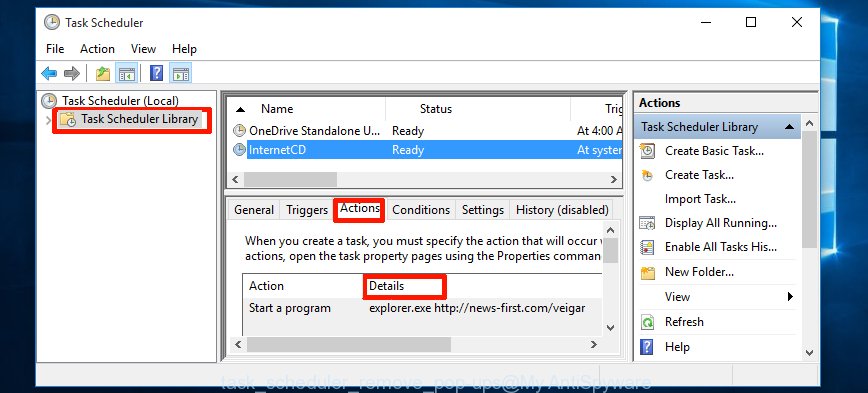
Task scheduler, list of tasks
In the middle part you will see a list of installed tasks. Select the first task, its properties will be show just below automatically. Next, press the Actions tab. Necessary to look at the text which is written under Details. Found something suspicious, then you need remove this task. If you are not sure that executes the task, then google it. If it’s a component of the adware, then this task also should be removed.
Further click on it with the right mouse button and select Delete as displayed below.

Task scheduler, delete a task
Repeat this step, if you have found a few tasks that have been created by adware. Once is complete, close the Task Scheduler window.
How to remove adware from Windows 10 with free tools
There are not many good and free adware removal tools with high detection ratio. The effectiveness of adware removal utilities depends on various factors, mostly on how often their adware/malware signatures DB are updated in order to effectively detect modern malicious software, adware, browser hijackers and other PUPs. We advise to use several applications, not just one. These programs which listed below will help you get rid of all components of adware from your disk and Windows registry and thereby delete any unwanted ads and pop-ups.
How to remove adware with Zemana Anti-malware
You can download and use the Zemana for free. This adware removal tool will scan all the Microsoft Windows registry keys and files in your computer along with the system settings and web-browser plugins. If it finds any malicious software, adware or harmful extension then the Zemana AntiMalware (ZAM) will remove them from your system completely.
Zemana Free can be downloaded from the following link. Save it to your Desktop so that you can access the file easily.
164998 downloads
Author: Zemana Ltd
Category: Security tools
Update: July 16, 2019
Once the download is done, close all windows on your PC system. Further, run the install file named Zemana.AntiMalware.Setup. If the “User Account Control” dialog box pops up as displayed on the screen below, click the “Yes” button.

It will open the “Setup wizard” which will help you install Zemana AntiMalware on the computer. Follow the prompts and do not make any changes to default settings.

Once setup is done successfully, Zemana Free will automatically start and you can see its main window as displayed on the image below.

Next, click the “Scan” button . Zemana AntiMalware (ZAM) utility will start scanning the whole personal computer to find out adware that causes multiple intrusive ads. A scan can take anywhere from 10 to 30 minutes, depending on the count of files on your PC and the speed of your PC system. While the Zemana Anti-Malware program is checking, you may see how many objects it has identified as threat.

After the system scan is done, Zemana Anti-Malware will show a screen that contains a list of adware that has been detected. Review the report and then click “Next” button.

The Zemana Anti Malware (ZAM) will delete adware and add all security threats to the Quarantine. After finished, you may be prompted to reboot your PC.
Use Hitman Pro to remove adware from Windows 10
Hitman Pro frees your Windows 10 (and other versions of Windows OS) from adware, browser hijackers, potentially unwanted programs, unwanted toolbars, web browser extensions and other unwanted programs. The adware removal tool will help you enjoy your PC to its fullest. HitmanPro uses advanced behavioral detection technologies to detect if there are adware in your system. You can review the scan results, and select the threats you want to erase.
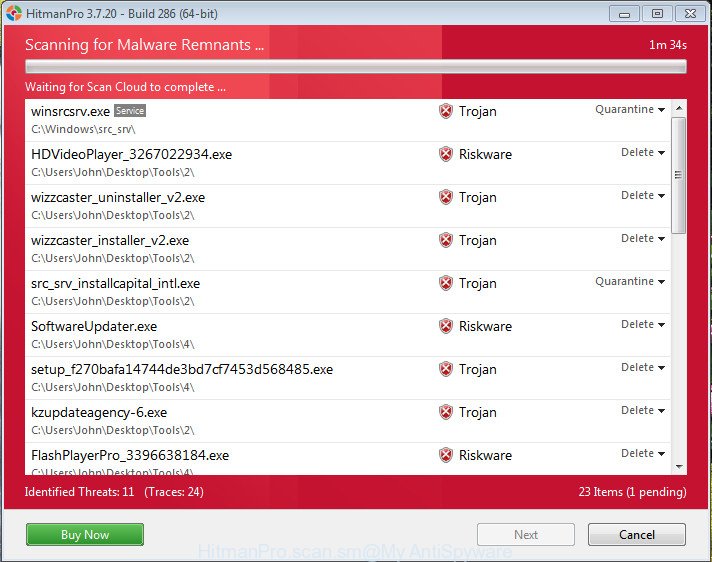
- HitmanPro can be downloaded from the following link. Save it on your Microsoft Windows desktop or in any other place.
- Once the download is finished, double click the HitmanPro icon. Once this utility is started, click “Next” button to begin scanning your system for adware and other unwanted software. A scan may take anywhere from 10 to 30 minutes, depending on the count of files on your computer and the speed of your personal computer. While the utility is scanning, you can see how many objects and files has already scanned.
- Once HitmanPro has finished scanning, HitmanPro will display a list of detected items. Once you’ve selected what you wish to get rid of from your PC system press “Next” button. Now click the “Activate free license” button to start the free 30 days trial to delete all adware found.
Use Malwarebytes to remove adware
We recommend using the Malwarebytes Free. You can download and install Malwarebytes to search for adware and thereby remove any unwanted advertisements from your internet browsers. When installed and updated, the free adware remover will automatically check and detect all security threats present on your PC.
MalwareBytes AntiMalware can be downloaded from the following link. Save it on your MS Windows desktop or in any other place.
327237 downloads
Author: Malwarebytes
Category: Security tools
Update: April 15, 2020
When the downloading process is complete, close all programs and windows on your machine. Open a directory in which you saved it. Double-click on the icon that’s called mb3-setup like below.
![]()
When the installation starts, you will see the “Setup wizard” that will help you install Malwarebytes on your PC.
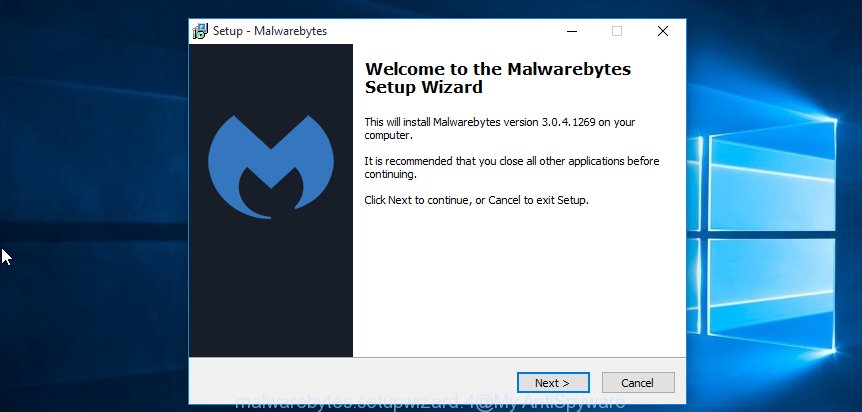
Once install is done, you’ll see window as displayed on the image below.
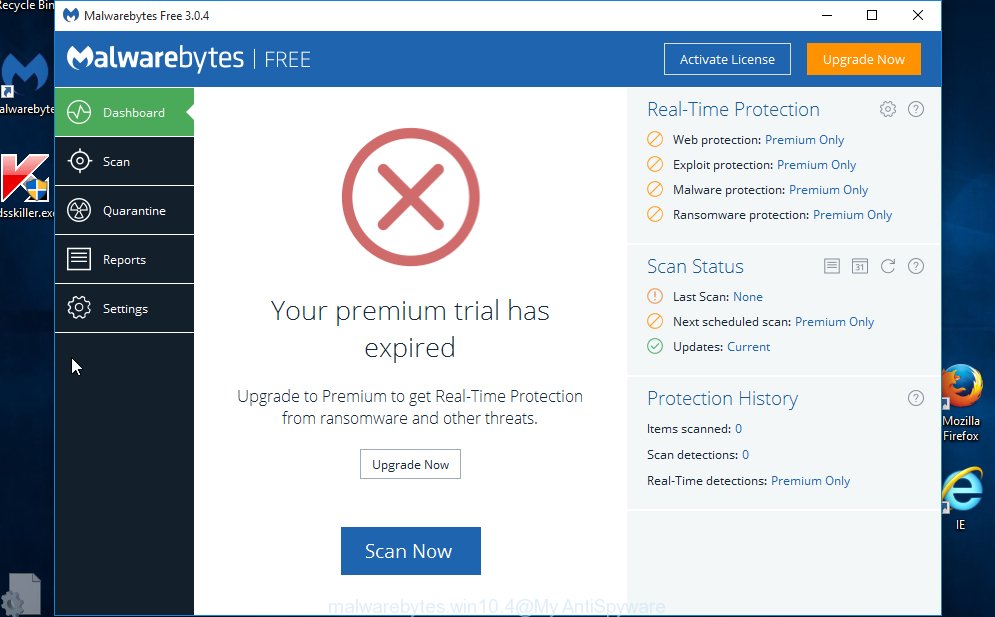
Now click the “Scan Now” button to detect adware related to annoying pop-up ads. This process can take quite a while, so please be patient. While the MalwareBytes Anti-Malware program is scanning, you can see number of objects it has identified as adware, malware or other security threat.
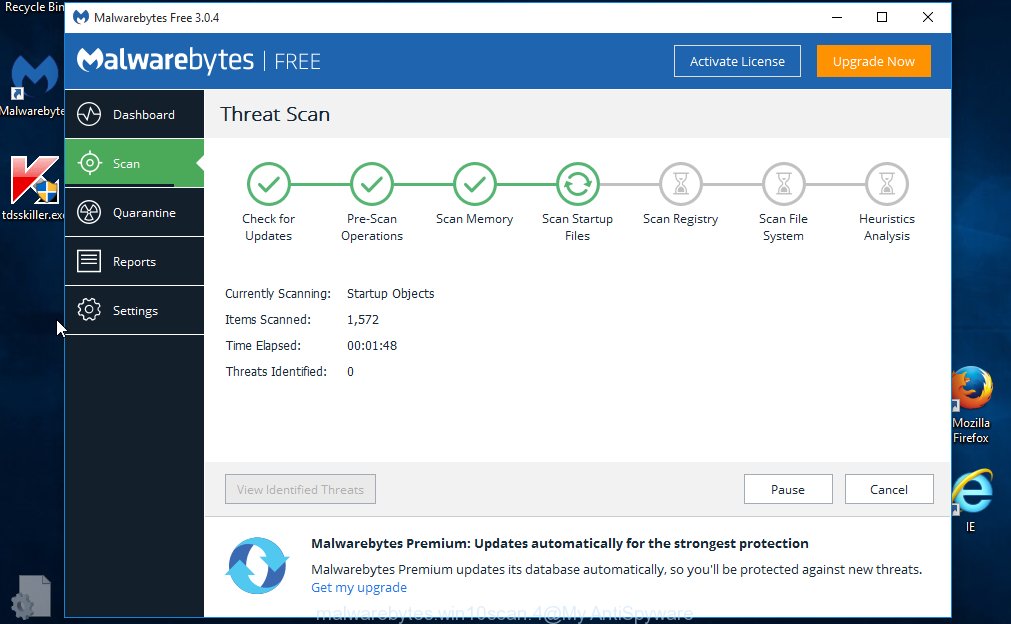
After the scanning is finished, the results are displayed in the scan report. Review the report and then press “Quarantine Selected” button.
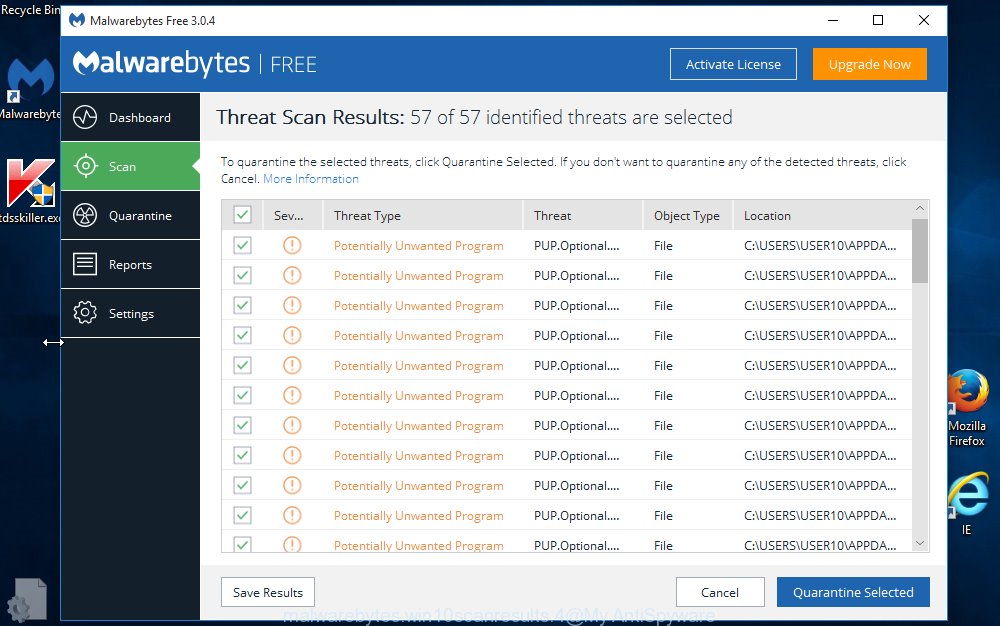
The Malwarebytes will now remove adware and move all malicious items to the program’s quarantine. When disinfection is finished, you may be prompted to restart your PC system.

The following video explains step-by-step instructions on how to remove adware and other malicious software with MalwareBytes Anti-Malware.
Install AdBlocker
After completing all the steps above, you were able to remove adware from Windows 10. Now it’s time to think about how to protect your computer from adware and other malicious software. One of the simplest ways to deal with adware is to block all malicious and misleading ads. Since adware writers often use misleading advertising to force users to go to a malicious site that can infect a computer with an adware or force users to download and install an adware on their computer. By installing an AdBlocker like AdGuard, you’re able to block malicious and misleading ads, autoplaying video ads and other annoying ads on web-sites.
- Download AdGuard from the following link. Save it on your Desktop.
Adguard download
26885 downloads
Version: 6.4
Author: © Adguard
Category: Security tools
Update: November 15, 2018
- Once the downloading process is done, run the downloaded file. You will see the “Setup Wizard” program window. Follow the prompts.
- After the installation is complete, click “Skip” to close the setup program and use the default settings, or click “Get Started” to see an quick tutorial which will assist you get to know AdGuard better.
- In most cases, the default settings are enough and you don’t need to change anything. Each time, when you start your system, AdGuard will start automatically and block annoying ads, as well as other harmful or misleading web-sites. For an overview of all the features of the program, or to change its settings you can simply double-click on the icon named AdGuard, which is located on your desktop.
How did you get infected with adware
The adware is bundled within certain free software. So always read carefully the setup screens, disclaimers, ‘Terms of Use’ and ‘Software license’ appearing during the install procedure. Additionally pay attention for optional programs that are being installed along with the main application. Ensure that you unchecked all of them! Also, run an AdBlocker that will help to stop malicious, misleading, illegitimate or untrustworthy webpages.
Finish words
After completing the few simple steps outlined above, your computer should be clean from adware and other malware. The Google Chrome, Edge, Mozilla Firefox and Microsoft Internet Explorer will no longer reroute you to various undesired ads. Unfortunately, if the steps does not help you, then you have caught a new adware, and then the best way – ask for help in our Spyware/Malware removal forum.




















